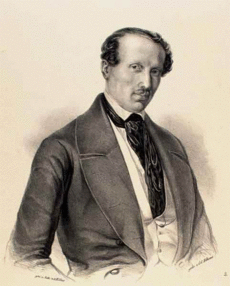Hans Christian Lumbye facts for kids
Hans Christian Lumbye (Danish pronunciation: [lɔmˈpyː]; born May 2, 1810 – died March 20, 1874) was a famous Danish composer. He wrote many lively pieces of music, including waltzes, polkas, mazurkas, and galops. People often called him "The Strauss of the North" because his music was similar to the famous Austrian composer Johann Strauss I.
Contents
Early Life and Music Beginnings
Hans Christian Lumbye started his musical journey when he was young. He studied music in the Danish cities of Randers and Odense. By the time he was 14 years old, he was already playing the trumpet in a military band.
In 1829, he moved to Copenhagen and joined the Horse Guards. He continued to learn and improve his music skills there. A big moment for him happened in 1839 when he heard a Viennese orchestra play music by Johann Strauss I. This inspired him greatly, and he began to compose music in a similar exciting style.
A Popular Composer in Denmark
From 1843 to 1872, Lumbye worked as the music director and main composer for Tivoli Gardens, Copenhagen. This was a very popular amusement park and garden in Denmark's capital city. His music became incredibly popular with the Danish people.
He was so loved in Denmark that many Danes even thought of Johann Strauss II (the son of Johann Strauss I) as "the Lumbye of the South." This shows just how much they admired Hans Christian Lumbye and his wonderful music.
Famous Musical Works
Lumbye is best known for his fun and light-hearted compositions. Many of his pieces tell a story or bring to mind sounds from everyday life. For example, his famous Champagne Galop starts with a sound that makes you think of a champagne cork popping!
Another great example is the Copenhagen Steam Railway Galop. This piece cleverly sounds like a train. You can almost hear it chugging out of a station and then slowing down to a stop. He also honored the famous singer Jenny Lind with a waltz called "Souvenir de Jenny Lind, Vals" in 1845.
Exciting Galops
Galops are fast and lively dances. Lumbye wrote many popular ones:
- Jubel-Galop (1840 or 1844)
- Juliane Galop (1843-1844)
- Telegraph Galop (1844)
- Castilianer-Galop (1847)
- Copenhagen Steam Railway Galop (1847)
- Capriccio Galop (1851)
- Juleballet (1855)
- Champagne Galop (1865)
- Cirque de Loisset Galop (1862)
- Bouquet-Royal Galop (1870)
- Kanon Galop (1853)
Grand March Music
Lumbye also composed several marches, which are often played for parades or special events:
- Marche du Nord (1856-1857)
- Kronings Marsch (1860)
- Kong Frederik den Syvendes Honneur-Marsch (1861)
- Kong Christian D. 9des Honneur March (1864)
- Kong Carl d. XVdes Honneur March (1869)
- Kong Georg den 1stes Honneur Marsch (1973)
Fun Polkas
Polkas are another type of lively dance music that Lumbye enjoyed writing:
- Caroline Polka (1843)
- Casino-Polka (1846)
- Amager-Polka (1849)
- Camilla Polka (1863)
- Otto Allins Tromme-Polka (1863/1864)
- Petersborgerinden
Beautiful Waltzes
Waltzes are graceful, flowing dances. Lumbye's waltzes were also very popular:
- Krolls Ballklänge
- Amelie-Vals
- Casino Vals (1847)
- Catharina Vals (1857)
Family and Legacy
Hans Christian Lumbye had two sons who also became musicians: Carl Christian (born 1841 – died 1911) and Georg August (born 1843 – died 1922). After their father passed away, they continued his musical legacy by taking over his orchestra.
His grandson, Georg Høeberg, also became a very important Danish conductor. He led orchestras at the famous Det kongelige Teater (The Royal Danish Theatre).


